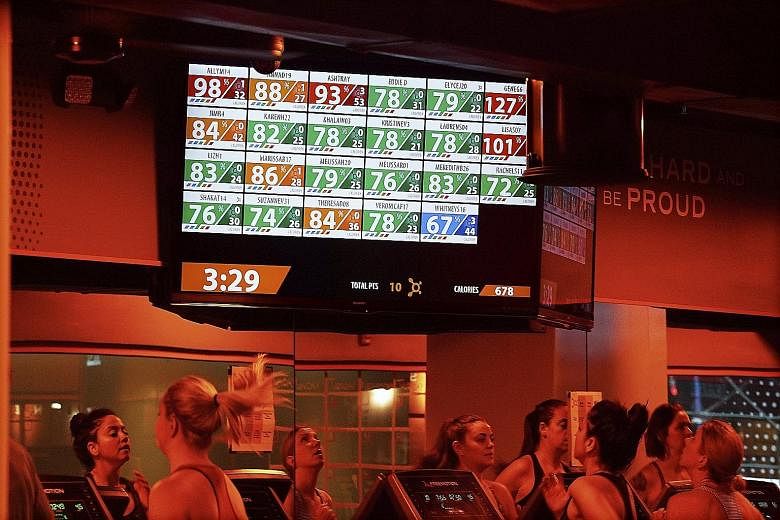NEW YORK • Every era gets the fitness culture it is meant to have. The aerobics craze, propelled by actress Jane Fonda, took off in the 1980s when the hedonism that distinguished the 1970s began to give way to a new urban ethic of busyness, long hours and the march towards more and more money.
Beginning in the 1990s, cities such as New York saw the rise of high-end gyms, which ensured that working out, like drinking coffee, would become another sociallytiered experience.
More recently, there has been the explosion of boutique fitness studios such as SoulCycle. Like certain iterations of yoga, it has been a success in part because it makes submission to a luxury-brand experience feel like spiritual enrichment. On some level, it aims to alleviate your guilt. The US$34 (S$48) you are spending on 45 minutes of stationary biking is going to improve you as a person and the world, in turn, will be a better place for all of your growth.
Orangetheory, the latest trend, comes with no veneer of the mystical and little of the "wellness" jargon. The hour-long classes combine cardio with push-ups, plyometrics and free weights.Orangetheory is a franchise business, with 325 branches in the United States and about 500 more branches coming, including one in Tokyo.
Its gimmick is an added element of the Darwinian.
Clients wear monitors during the sessions that measure heart rate and the number of calories burned; individual performance statistics are then broadcast on electronic boards at the front of the class with your name. Levels of output are colourcoded and the goal is to spend at least 12 minutes, but preferably more, in the orange zone, which measures maximum effort. The programme stresses that your best effort is good enough, but competition, or rather the terror of winding up with the lowest score in the class, keeps you breathlessly pushing forward.
A class I took recently went back and forth between rowing machines and treadmill running before ending with a weight routine under the direction of a very good and eager teacher who called himself Coach Ben. I burned 545 calories in one hour and spent 16 minutes in the orange zone, which felt like an outcome I could brag about until I noticed that ChrisP20 had burned 848 calories during the same time and spent 22 minutes in the orange zone.
If SoulCycle is the preferred workout of well-off mothers with time on their hands, Orangetheory is the workout of strivers. It was not conceived as an elitist enterprise. In some parts of the US, classes can be taken for as little as US$13 each.
Orangetheory was founded five years ago by Ms Ellen Latham, who in the late 1990s had been let go from a job running a fitness centre in Miami Beach. She started teaching Pilates classes out of a room in her house, but was perplexed by a question: "How could I get fat blowing off my Pilates clients?"
To surpass the limits of toning, she created the one-hour metabolic workout that grew into Orangetheory, incorporating work that drives up heart rate and helps people to lose weight. If there are certain exercises a client cannot manage, instructors provide alternatives. "I've eliminated the word modifications because I don't like it. We use 'options' now because modification makes people feel 'less than', " she said.
If Orangetheory becomes an obsession with people, it may be because they are starting to become fatigued with cycling in dark rooms with scented candles or because they want something with a different competitive challenge from, say, CrossFit.
More likely, they always want to know where they rank.
NEW YORK TIMES

